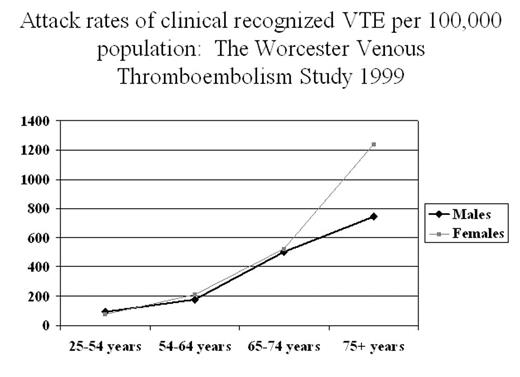Abstract
Background: Although increasingly recognized as a major clinical problem, most reported estimates of the attack rates of venous thromboembolism (VTE) are based on studies enrolling patients more than a decade ago. Given changes in patient characteristics, risk factor profiles, and prophylaxis strategies over time, more current estimates are needed if we are to better target high-risk patients and allocate limited health care resources. The purpose of this study was to describe crude, as well as age and gender adjusted, attack rates of deep vein thrombosis (DVT) and pulmonary embolism (PE) in residents of the Worcester Statistical Metropolitan Area (SMSA) during the year 1999.
Methods: The medical records of all male and female residents from the Worcester SMSA (2000 census = 478,000) diagnosed with ICD-9 codes consistent with possible DVT and/or PE at all 11 greater Worcester hospital during 1999 were reviewed by trained data abstractors. Characterization of each case of VTE was classified as definite, probable, or possible using prespecified criteria. For purposes of this analysis we approximated attack rates for the total Worcester SMSA population. However, for several specific analyses we have excluded 15 cases of validated VTE occurring in patients < 25 years of age. Age and sex-specific attack rates were calculated in a standard manner. Attack estimates were based on 2000 Massachusetts Census data for the Worcester SMSA which reported 287,631 residents 25 years of age or older.
Results: There were a total of 590 recognized episodes of VTE in residents of the Worcester SMSA yielding an approximate attack rate of 123/100,000 population. Approximately one quarter of patients developed VTE during hospitalization for another indication while the remaining three quarters presented to the hospital with VTE. Excluding 15 cases of VTE occurring in patients < 25 years of age yields an attack rate of 200 per 100,000 population (95% C.I. 184, 216). Our study sample included 420 cases of isolated DVT (146/100,000 population), 140 cases of PE with or without DVT (49/100,000 population), and 74 cases of recurrent DVT (26/100,000 population). Overall, attack rates of DVT and PE for females were similar to those of men (DVT 152/100,000 vs 139/100,000; PE 51/100,000 vs 45/100,000). However attack rates in females age 75 years and older were significantly greater than those in men of the same age. The age and specific attack rates of clinically recognized VTE are shown in Figure 1.
Conclusions: The annual overall attack rate of VTE in this community based study was slightly higher than that reported in the initial Worcester DVT study of 1985/1986 (107/100,000). In addition, if one excludes the small number of cases of VTE occurring in the young, attack rates/100,000 are almost doubled and increase rapidly with age particularly in women. These data have important implications for targeting of VTE prophylaxis and utilization of health care resources.
Attack rate of clinical recognized VTE per 100,000 population: The Worcester Venous Thromboembolism Study 1999
Attack rate of clinical recognized VTE per 100,000 population: The Worcester Venous Thromboembolism Study 1999
Author notes
Corresponding author


